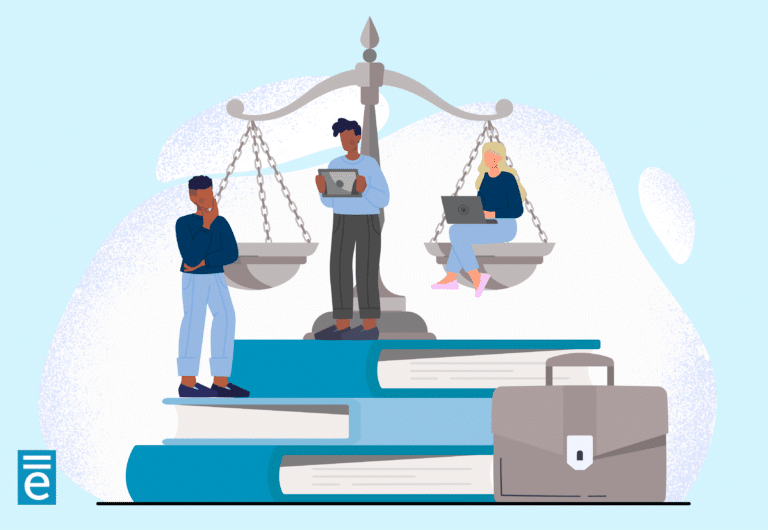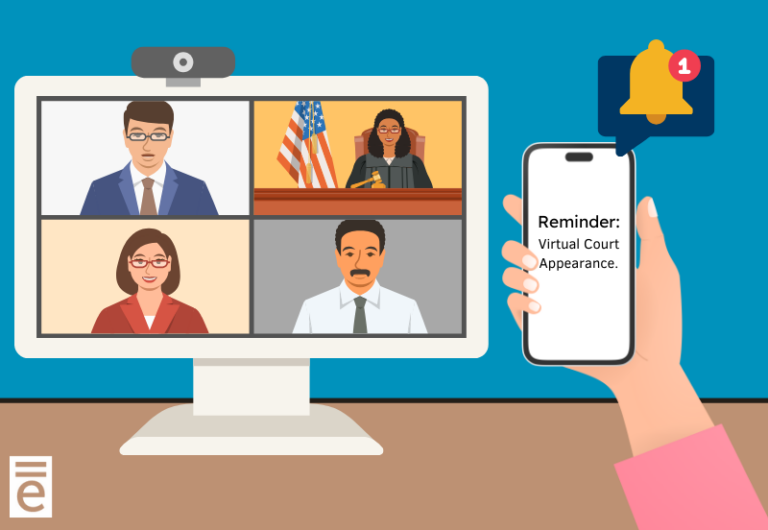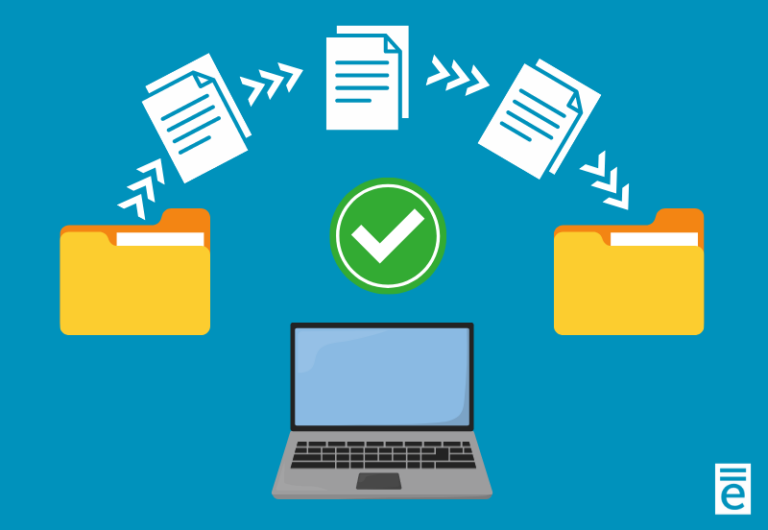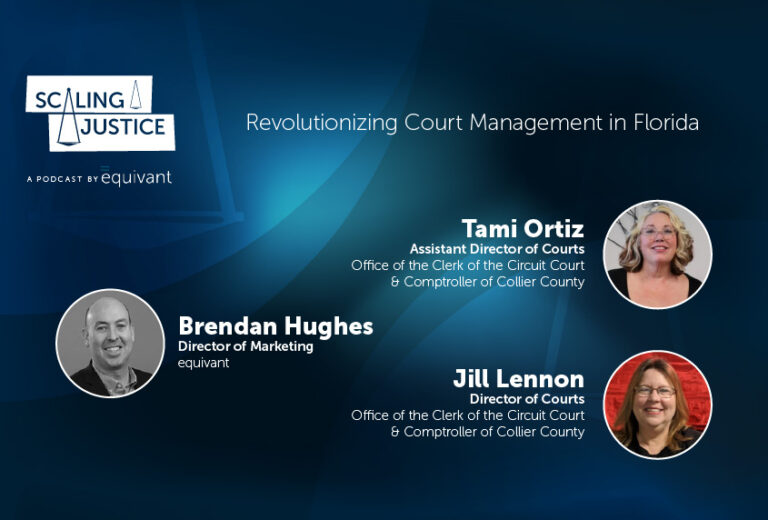Get Simple Tips to Improve Court Management
Managing the business of courts and case management can be challenging. The pressure to deliver only increases as stakeholders demand a more virtual environment.
Join Sherry-Lynn Agcanas-Wolf, equivant Director of Product Management, as she reveals how straightforward process planning, implementing basic automation functions, and simple case management tactics can relieve court staff workloads and increase overall efficiency.
Watch now:
Related Links
Interested in this topic? Download our whitepaper, Simplifying Court and Case Management in 4 Steps, for a deeper dive.
Simple Tips to Maximize Court and Case Management Efficiency Transcript
Brendan Hughes: All right. Well, let’s get started. Hello and welcome, everyone, to Simple Tips to Maximize Court and Case Management Efficiency. I’m your host, Brendan Hughes, Director of Marketing at equivant. I’ll be joined by my colleague, Director of Product Sherry Agcanas-Wolf, in a moment. But first, I wanted to set the stage for today’s presentation. Let’s see if we can summarize the current situation at your court in a few words. I imagine it’s busy dockets, working with legacy infrastructure, overwhelmed staff or not enough staff, too little budget, and probably increased expectations from just about everybody. From courts, agencies, judges, the community, everyone wants everything in an instant and everybody probably wants it virtually now, online. A lot of demands coming your way right now. This probably all sounds a bit familiar.
I will say that we have solutions. That’s why we’re here today, to talk to you a little bit about that. If I can take a moment to go through a quick agenda for you. We’re here today to share best practices and solutions we’ve learned from years and years of experience working with courts and justice agencies of all sizes across the country. We’re going to review some simple things to help you guys maximize efficiency and effectiveness. If you’re hoping to gain some insights on how to address those challenges I just mentioned, then you are in the right place. What we’re going to do is we’re going to speak to Sherry here in a moment and do a quick overview of myself, and Sherry, and our company, and then we’re going to jump into the tips. We’ll do this in a Q&A format with Sherry, and then we’ll summarize what we’ve covered, and then answer any questions you might have.
We’re setting aside a Q&A at the end, but if you have a question or comment along the way, feel free to enter it in the chat function at any point. It’ll be on the right, and we’ll make sure we keep an eye out for that, but we’ll try to address everything at the end. All right. As I said, my name is Brendan Hughes. I’m Director of Marketing here at equivant, and one of my main goals is to bring awareness to our subject matter experts, like Sherry and others at equivant, and the innovative solutions they’ve developed over decades. It’s all to help build more efficient, effective, and equitable justice agencies nationwide. The star of the show is most definitely Sherry. Instead of me reading off her bio, I’m going to have Sherry tell you about herself right now. But before I do, actually before I do, a quick fun fact is that Sherry is based out of Orlando, Florida, but is originally from Tennessee. Isn’t that right, Sherry?
Sherry-Lynn Agcanas-Wolf: That is right, Brendan. I’m from Memphis, Tennessee, I actually still consider Memphis my hometown. I spent my childhood there, a proud graduate of Bolton High School in Shelby County, and I still have family there in Tennessee and Shelby and Tipton County. Professionally, I’ve been working with justice agencies for over 20 years with the mission to simplify the justice process for everyone. As equivant Director of Product, I want our solutions to solve your agency’s business problems so you can serve your community effectively, and I’m excited to be here to talk with all of you.
Brendan Hughes: Great. Well, thanks, Sherry. Real quick before we get into the meat of everything, I wanted to provide a high level overview of equivant. As we’ve been saying, we’ve been developing and implementing innovative solutions for more than 30 years, and those solutions have been focused on basically what the topic of this webinar is. It’s helping courts and other agencies become more efficient, and effective, and equitable. I also wanted to share a few numbers behind the success of equivant, but not to spend too much time here because we want to get to the meat of the event. But I do want to emphasize one thing, and that is our mission is to simplify justice for all.
We build innovative solutions to simplify justice. It’s our passion. The reason we are here and the reason we’re in business is to make your work environments better and make your work lives easier. Just wanted to make sure we reiterate that before we get started. As we get started now, Sherry, why don’t we bring some focus to the discussion? I outlined a number of challenges that we’re probably all facing, but let’s focus on probably the main goal of a court is to get persons and cases through the entire process as efficiently as possible. Why don’t we start there?
Sherry-Lynn Agcanas-Wolf: Okay. When we don’t pay attention to workflow and how it affects caseflow, then we see problems. Brendan mentioned them, like increased stress for staff, increased costs, which may affect court’s budget or participants’ legal fees. Overall, we see a potential for deficient procedural fairness, which can affect how the community perceives the effectiveness of the justice system. We’ll be talking through tips and how we can help solve some of those issues.
Now, before we get too far into the topic, I want to explain the difference between caseflow and workflow, because I often hear those terms used interchangeably, and we’ll be using those terms a lot today. Caseflow is the process of moving cases through the necessary steps to ensure due process and equal treatment for all litigants and defendants. When done effectively, caseflow management ensures timely resolution of all the cases that are filed. Workflow supports caseflow, and workflow does that by ensuring the tasks are complete on time to keep that caseflow moving. Workflow also involves automating triggers and notifications to continue to move that case through its timeline. It’s basically how the caseflow objectives are meant.
Brendan Hughes: All right. Yeah. Well, that’s great. I know this is something that you’re passionate about. What are some ways that you can identify and establish effective workflows that support caseflow?
Sherry-Lynn Agcanas-Wolf: Absolutely. Courts usually know the predetermined path for a case or a person to move through the justice system. Within that caseflow, courts should identify tasks that fill a person’s day or staff’s day and automate those tasks as much as possible. These tasks are part of your workflow. Identifying workflows is all about considering all of your resources, your people, your paperwork, and how that all moves around. You want to review those tasks, and not like their occupations because you’re not going to replace a department head with a computer. You want to identify tasks to be done so we can automate those and your staff can focus on more meaningful work so they’re not tied to rote tasks every day.
Brendan Hughes: That makes a ton of sense. One of the things that you probably run into a lot is that a lot of common issues that impact moving those things forward. A lot of times, people call these bottlenecks. Can you talk a little bit about some of the ones you’ve seen and what can be done about them?
Sherry-Lynn Agcanas-Wolf: Sure. Bottlenecks and caseflow is basically work not getting done. Let’s say a new filing sits too long in an inbox, so there’s a delay in notifying opposing parties or getting resolution on a motion. In workflow, that receipt of filing is automatically tracked. Notification goes out to the responsible parties so they can attend to the next step. Another example would be when you can’t verify service on all the participants. Court events get rescheduled. Court events with multiple continuances tend to delay caseflow. A workflow should be able to evaluate participant status for an upcoming court date, and that should produce the tasks and notices out to the participants. One more example would be time guidelines. Deadlines that are missed on say criminal cases could affect speedy trial. We recommend a workflow that tracks those milestones and then sends notifications out possibly through email or text message as reminders for those guidelines.
Brendan Hughes: Okay. Yeah, that makes sense. As you’re talking about these things, the one thing that comes to mind is that… You’ve mentioned three right there, but knowing the courts and how busy they are and how many tasks they have, those are just three of tens of hundreds, maybe almost, of tasks that are going on at once. It brings the question to mind about automating these tasks as a way to boost efficiency. I know automation is almost like a buzzword, but it’s more than just taking a manual task and making it digital, because I know I’ve heard you speak before about it’s also digital tasks. The things that are already at a digital way is taking those common repeatable digital tasks and automating that functionality. I know that’s something you want to highlight right now too, is the automation of digital tasks.
Sherry-Lynn Agcanas-Wolf: Yeah, absolutely. I like to use taking traffic citation payments as an example because it can be a manual process. You’re taking traffic tickets over the counter, and sometimes the first thing that we do to digitize that process is take online payments. You introduce online payments to move into the digital world, but there’s still other case processing that needs to occur. Once you receive that payment, you have to set the charge disposition, you have to adjudicate the case, maybe you need to cancel any future events or other due dates that may be on the case. You have to notate all these updates on the register of actions, and you probably have to send that final disposition to the state.
In a workflow scenario, you may… Well, I should say, on a CMS, you may already be doing these tasks digitally. But if you have a dynamic workflow in place, then all of these tasks can be automated to be triggered by that receipt of the traffic payment. Whether you’re doing just a couple of handfuls of citations or hundreds of citations, then doing all those steps, reducing that workload for those repeatable tasks of disposing the case, et cetera, all that hits all the benefits that we have listed here, where it identifies bottlenecks. It reduces errors, it documents your caseflow. It basically increases your efficiency and it truly ensures that you adhere to court rules and policies, and possibly even introducing improvements to them because you’re having all those tasks digitized and automated.
Brendan Hughes: Yeah, that makes a ton of sense. Drawing back to the first slide I had about the challenges of staff, overworked staff, limited staff, you can see a direct line between what you’re describing here and alleviating some of those benefits there or those challenges. The challenges of staffing and the amount of time spent on some of these things, automating that process has numerous benefits and really starts to alleviate some of those common challenges that all courts are facing. Good insight there. One thing you touched on was CMS, and all courts have some level of system that helps manage their cases. Whether it’s something that they’ve built themselves over the years or it’s a product, it’s something that…
Similar to equivant, we have a CMS product, multiple products, and others do as well, but combining that workflow and caseflow with a CMS is important. The way you were just kind of outlining this is if your court is starting to review and outline processes in the best way you want to operate, you want that to match with the way your system is working, your CMS. What are some things you should expect from a CMS to match and make it work well with your workflow? I guess, on top of that, it’s probably pretty critical to have your court and the CMS is built for your workflow, right?
Sherry-Lynn Agcanas-Wolf: Absolutely, absolutely. Just as workflows is one of the… Maybe the single most important factor for effective caseflow, workflows should be the heart of your CMS. It’s how the cases flow through your application. Right now, dynamic workflow is a game changer for case management systems, and should be one of your deciding factors when you’re evaluating your current CMS. At equivant, we believe that a court shouldn’t have to dramatically alter its processes to fit into a CMS, and the system should be configurable and flexible enough to allow the system to change with court processes. As those policies and as those rules change, then the CMS grows and flexes with you. The system should be able to collaborate across multiple agencies, and departments, and teams throughout that whole case life cycle. It should monitor the workflow. You’re getting triggered and alerted to move that work to the next phase when those due dates or those milestones are met.
When a case doesn’t move like it should, then your CMS should be evaluating that and letting you know of those delays and those roadblocks. They probably should do all of that automatically and almost annoyingly, alerting you that you’ve got things stuck in your queue. I think it’s important to always know where your case is at any moment, where your caseflow is at any moment. Your CMS should be able to search against your workflows, what I like to call retrieve and rescue, so you can retrieve and rescue any cases are needing any attention. It’s important that your workflow, your caseflow, and your CMS are all working together so that you can be as efficient as possible.
Brendan Hughes: Yeah, that’s great points. Just, again, reiterating something you pulled out there, is that your CMS should match what you’ve established as your workflow, because I imagine there’s so many differences across the country and nationwide that the people that work at their courts and the administrators and clerk of courts and judges, they understand how to best work their court dockets and the way their courts should operate. If they’re working to audit themselves and establish workflows that work best for them, that it would only make sense that the CMS that’s helping to automate and trigger these things works the way they want it to work and not the opposite, right?
Sherry-Lynn Agcanas-Wolf: Exactly. Exactly.
Brendan Hughes: Great. All right. Well, I know we touched on a few things at this presentation today, and wanted to make sure we gave an overview of some simple things that we can identify and help with as far as maximizing some core efficiencies. Just a recap of where we are in that process is what we talked about today was we focused on efficiently moving cases from step to step and identifying that process. Common roadblocks and possible solutions, Sherry did a great job of identifying some potential bottlenecks within processes and some simple ways you guys can overcome those things. Automating digital tasks is a big thing. As we discussed there, Sherry identified some of the really important things to look for. It’s not just a manual task moving it to a digital environment. In fact, it’s more about a lot of digital tasks that are already processes but are being manually done or repeatable.
You can really start to lessen the work your staff is doing by establishing some automated tasks and making triggers and alerts a big part of that process to keep cases moving and going in the right direction. As we just talked about at the end here, it’s critical to have the support of your CMS and whatever system you’re using to make your business of the court move forward, that it matches those workflow processes. As Sherry was identifying at the top, really looking at how you can improve your own court efficiency, you want to make sure that the CMS can match that and work well with your own processes, and not have to be forced into doing things a certain way just because that’s the way the existing software or something a legacy infrastructure is forcing you guys to do that. Really good stuff at a high level that we talked about today, and appreciate, Sherry, all the insights that you’ve provided here today.
One thing that we wanted to provide to people as a free offer is we do have a whitepaper that goes into more detail on these topics. It’s something that Sherry authored. Again, it’s a great whitepaper that is more into the details of what we talked about today on workflow, and caseflow, and matching that with technology. It’s a powerful combination to have the technology as well as your own workflow. We have this whitepaper free for anybody that would like to claim it. The presentation that we have or giving today is available in the box below the presentation on this portal. There’s a download, so you can grab the whole PowerPoint deck and click on the link or scan the QR code and you can access that right now.
That’s the bulk of our presentation. I didn’t know if there was any Q&A that we need to get to. One of the things, Sherry, that maybe we could touch on real quick is that we just touched on a number of these things at a high level, and there’s more in the whitepaper obviously, but it can seem probably a little intimidating to people. One of the things that I think a lot of people ask right away is where do they start if they want to tackle some of these things?
Sherry-Lynn Agcanas-Wolf: Absolutely. That’s a great question. What’s the next best thing you can do from here? I always recommend, we say, work out your Ws. What needs to happen? When does it need to happen? Who needs to know or contribute? Where does that information need to go? You ask yourself those questions about the things that happen to your case and clearly defining those processes, your what, when, who, and where. Understanding all those moving parts is a really good step to automating them.
Brendan Hughes: Great. Well, I think that’s it for today. I don’t see any questions at the moment. I appreciate again your time, Sherry, and thank you to everybody that’s attended. Again, to reiterate, this is stuff that we’re passionate about. This is something we enjoy talking about. If you have any questions or want to contact us about this topic, or anything related to any solutions for the justice space, feel free to reach out to Sherry or myself. Thank you, everybody.
Sherry-Lynn Agcanas-Wolf: Thanks.




